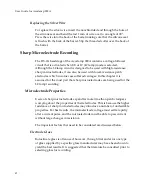
User
Guide
for
Axoclamp
900A
General
Rule
for
Choosing
a
Headstage
The
general
rule
for
intracellular
microelectrode
recording
is
that
the
resistor
in
the
headstage
(R
0
)
should
be
between
1/3
and
3
times
the
value
of
the
electrode
resistance,
R
e
.
If
the
R
0
value
is
less
than
1/3
R
e
,
the
wideband
noise
will
increase
and
the
headstage
leakage
current
might
cause
DC
errors.
If
the
R
0
value
is
greater
than
3
times
R
e
,
the
voltage
drop
across
R
0
during
current
passing
might
be
excessive
and
the
bandwidth
might
be
compromised.
If
the
value
of
R
0
is
higher
or
lower
than
the
recommended
range,
there
is
a
gradual
deterioration
in
performance.
There
is
no
catastrophic
diminishment
of
performance,
and
in
many
instances,
the
user
will
be
blessed
with
adequate
performance
even
if
R
0
is
as
small
as
1/10
or
as
large
as
×10
R
e
.
USE RECOMMENDATION
NORMAL
INTRACELLULAR
(BRIDGE) RECORDING
Follow the general rule.
EXTRACELLULAR
RECORDING
Since there is no current passing, there is no upper
limit on R
in
. For example, the ×1 and ×0.1
headstages are equally suitable for a 1 M
Ω
extracellular electrode.
dSEVC and DCC
×1 and ×0.1 give the best dynamic performance.
TEVC
Usually use the largest reasonable H value for the
current-passing microelectrode (CHANNEL 2) and
the lowest reasonable H value for the voltage-
recording microelectrode (CHANNEL 1). For
example, use ×10 or ×1 for CHANNEL 2 and ×1 or
×0.1 for CHANNEL 1.
IONTOPHORESIS
To electrically eject charged molecules out the
microelectrode tip into the preparation, it is best to
use low resistance microelectrodes and high H
values. ×1 is the best general-purpose headstage
for iontophoresis of drugs or dyes.
Table
3
.
Recommended
headstages
for
different
applications.
76
















































